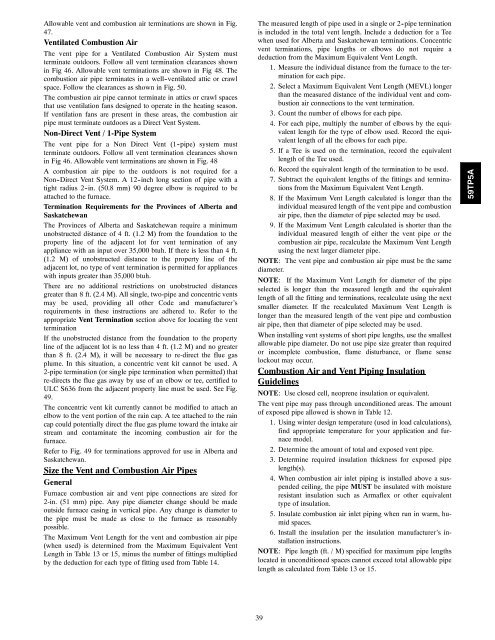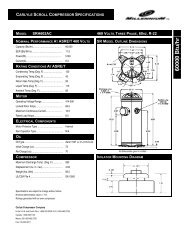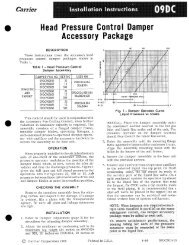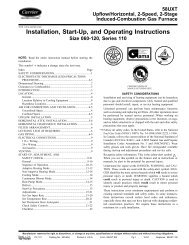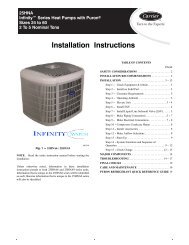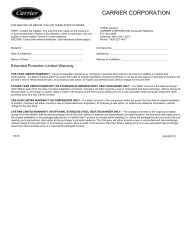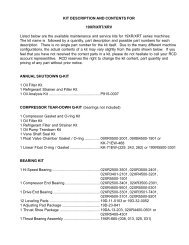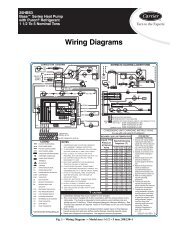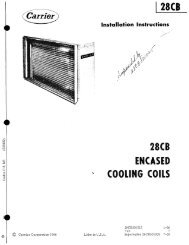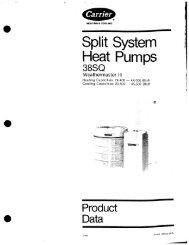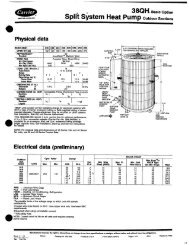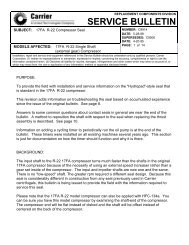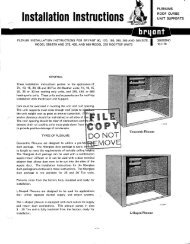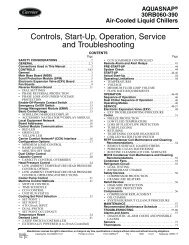warning - Docs.hvacpartners.com
warning - Docs.hvacpartners.com
warning - Docs.hvacpartners.com
Create successful ePaper yourself
Turn your PDF publications into a flip-book with our unique Google optimized e-Paper software.
Allowable vent and <strong>com</strong>bustion air terminations are shown in Fig.47.Ventilated Combustion AirThe vent pipe for a Ventilated Combustion Air System mustterminate outdoors. Follow all vent termination clearances shownin Fig 46. Allowable vent terminations are shown in Fig 48. The<strong>com</strong>bustion air pipe terminates in a well -ventilated attic or crawlspace. Follow the clearances as shown in Fig. 50.The <strong>com</strong>bustion air pipe cannot terminate in attics or crawl spacesthat use ventilation fans designed to operate in the heating season.If ventilation fans are present in these areas, the <strong>com</strong>bustion airpipe must terminate outdoors as a Direct Vent System.Non-Direct Vent / 1-Pipe SystemThe vent pipe for a Non Direct Vent (1 -pipe) system mustterminate outdoors. Follow all vent termination clearances shownin Fig 46. Allowable vent terminations are shown in Fig. 48A <strong>com</strong>bustion air pipe to the outdoors is not required for aNon -Direct Vent System. A 12 -inch long section of pipe with atight radius 2 -in. (50.8 mm) 90 degree elbow is required to beattached to the furnace.Termination Requirements for the Provinces of Alberta andSaskatchewanThe Provinces of Alberta and Saskatchewan require a minimumunobstructed distance of 4 ft. (1.2 M) from the foundation to theproperty line of the adjacent lot for vent termination of anyappliance with an input over 35,000 btuh. If there is less than 4 ft.(1.2 M) of unobstructed distance to the property line of theadjacent lot, no type of vent termination is permitted for applianceswith inputs greater than 35,000 btuh.There are no additional restrictions on unobstructed distancesgreater than 8 ft. (2.4 M). All single, two-pipe and concentric ventsmay be used, providing all other Code and manufacturer’srequirements in these instructions are adhered to. Refer to theappropriate Vent Termination section above for locating the ventterminationIf the unobstructed distance from the foundation to the propertyline of the adjacent lot is no less than 4 ft. (1.2 M) and no greaterthan 8 ft. (2.4 M), it will be necessary to re-direct the flue gasplume. In this situation, a concentric vent kit cannot be used. A2-pipe termination (or single pipe termination when permitted) thatre-directs the flue gas away by use of an elbow or tee, certified toULC S636 from the adjacent property line must be used. See Fig.49.The concentric vent kit currently cannot be modified to attach anelbow to the vent portion of the rain cap. A tee attached to the raincap could potentially direct the flue gas plume toward the intake airstream and contaminate the in<strong>com</strong>ing <strong>com</strong>bustion air for thefurnace.Refer to Fig. 49 for terminations approved for use in Alberta andSaskatchewan.Size the Vent and Combustion Air PipesGeneralFurnace <strong>com</strong>bustion air and vent pipe connections are sized for2-in. (51 mm) pipe. Any pipe diameter change should be madeoutside furnace casing in vertical pipe. Any change is diameter tothe pipe must be made as close to the furnace as reasonablypossible.The Maximum Vent Length for the vent and <strong>com</strong>bustion air pipe(when used) is determined from the Maximum Equivalent VentLength in Table 13 or 15, minus the number of fittings multipliedby the deduction for each type of fitting used from Table 14.The measured length of pipe used in a single or 2 -pipe terminationis included in the total vent length. Include a deduction for a Teewhen used for Alberta and Saskatchewan terminations. Concentricvent terminations, pipe lengths or elbows do not require adeduction from the Maximum Equivalent Vent Length.1. Measure the individual distance from the furnace to the terminationfor each pipe.2. Select a Maximum Equivalent Vent Length (MEVL) longerthan the measured distance of the individual vent and <strong>com</strong>bustionair connections to the vent termination.3. Count the number of elbows for each pipe.4. For each pipe, multiply the number of elbows by the equivalentlength for the type of elbow used. Record the equivalentlength of all the elbows for each pipe.5. If a Tee is used on the termination, record the equivalentlength of the Tee used.6. Record the equivalent length of the termination to be used.7. Subtract the equivalent lengths of the fittings and terminationsfrom the Maximum Equivalent Vent Length.8. If the Maximum Vent Length calculated is longer than theindividual measured length of the vent pipe and <strong>com</strong>bustionair pipe, then the diameter of pipe selected may be used.9. If the Maximum Vent Length calculated is shorter than theindividual measured length of either the vent pipe or the<strong>com</strong>bustion air pipe, recalculate the Maximum Vent Lengthusing the next larger diameter pipe.NOTE: The vent pipe and <strong>com</strong>bustion air pipe must be the samediameter.NOTE: If the Maximum Vent Length for diameter of the pipeselected is longer than the measured length and the equivalentlength of all the fitting and terminations, recalculate using the nextsmaller diameter. If the recalculated Maximum Vent Length islonger than the measured length of the vent pipe and <strong>com</strong>bustionair pipe, then that diameter of pipe selected may be used.When installing vent systems of short pipe lengths, use the smallestallowable pipe diameter. Do not use pipe size greater than requiredor in<strong>com</strong>plete <strong>com</strong>bustion, flame disturbance, or flame senselockout may occur.Combustion Air and Vent Piping InsulationGuidelinesNOTE: Use closed cell, neoprene insulation or equivalent.The vent pipe may pass through unconditioned areas. The amountof exposed pipe allowed is shown in Table 12.1. Using winter design temperature (used in load calculations),find appropriate temperature for your application and furnacemodel.2. Determine the amount of total and exposed vent pipe.3. Determine required insulation thickness for exposed pipelength(s).4. When <strong>com</strong>bustion air inlet piping is installed above a suspendedceiling, the pipe MUST be insulated with moistureresistant insulation such as Armaflex or other equivalenttype of insulation.5. Insulate <strong>com</strong>bustion air inlet piping when run in warm, humidspaces.6. Install the insulation per the insulation manufacturer’s installationinstructions.NOTE: Pipe length (ft. / M) specified for maximum pipe lengthslocated in unconditioned spaces cannot exceed total allowable pipelength as calculated from Table 13 or 15.59TP5A39


